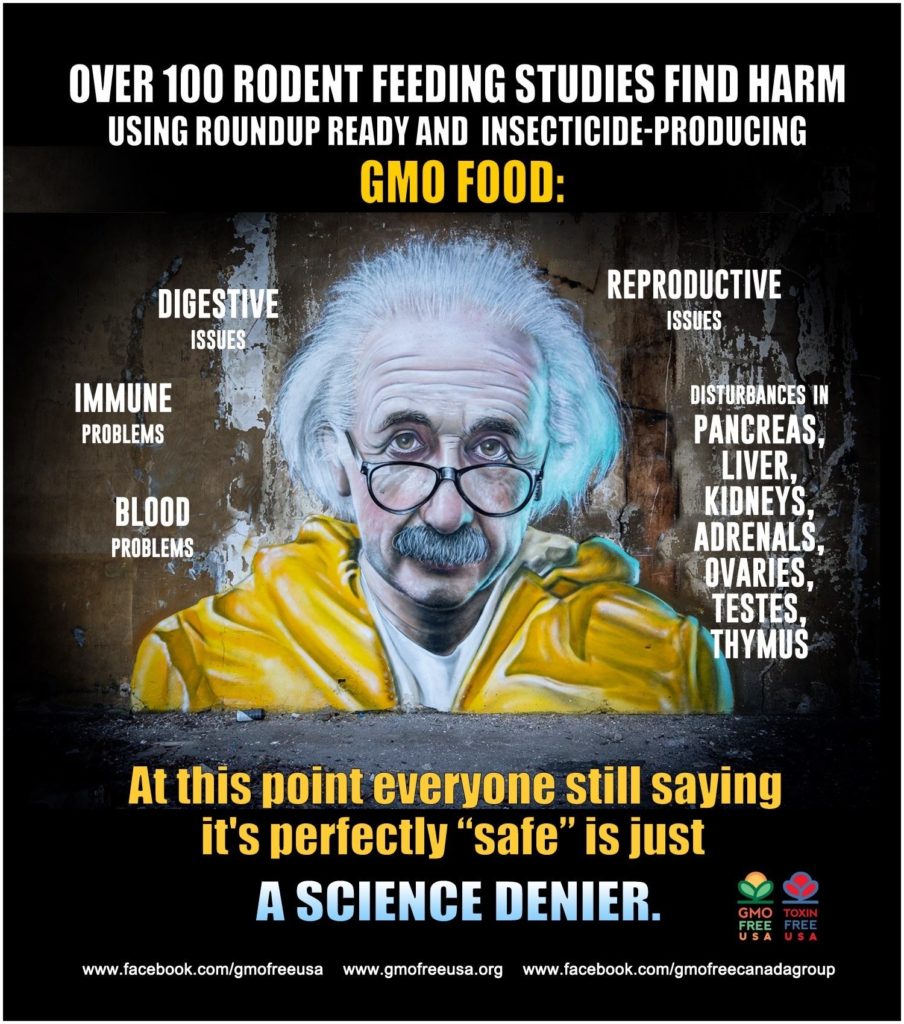Have your say! Geef commentaar! Het kan in het Nederlands!
| Soybean GMB151 EFSA Scientific Opinion on the assessment of genetically modified soybean GMB151, for food and feed uses, under Regulation (EC) No 1829/2003 (EFSA-GMO-NL-2018-153) EFSA opinion: 19 April 2021 EFSA opinion annexes Deadline: 22 May 2021 Send us your comments |

Ons commentaar:
“Over 100 rodent feeding studies find harm using Roundup Ready and insecticide-producing GMO-food: Digestive issues, reproductive issues, immune problems, blood problems, disturbances in pancreas, liver, kidneys, adrenals, ovaries, testes, thymus. At this point everyone still saying it´s perfectly “safe” is just a science denier.” Source: www.gmofreeusa.org
Our comment: And we can wait for the feeding studies that will find harm using HPPD herbicide-tolerant soybeans: a new type of GMOs. Moreover it is possible they will use Roundup before planting and before harvest.
Proven: Glyphosate herbicides change gene function and cause DNA damage.
Details
Published: 27 April 2021
Bombshell finding could end EU authorization of glyphosate. Report: Claire Robinson
Glyphosate-based herbicides such as Roundup activate mechanisms involved in cancer development, including DNA damage – and these effects occur at doses assumed by regulators to have no adverse effects, a new study shows. The DNA damage was caused by oxidative stress, a destructive imbalance in the body that can cause a long list of diseases.
In-depth comparative toxicogenomics of glyphosate and Roundup herbicides: histopathology, transcriptome and epigenome signatures, and DNA damage
Robin Mesnage, Mariam Ibragim, Daniele Mandrioli, Laura Falcioni, Fiorella Belpoggi, Inger Brandsma, Emma Bourne, Emanuel Savage, Charles A Mein, Michael N Antoniou
doi: https://doi.org/10.1101/2021.04.12.439463
———————————————————————————————————————–
- COGEM abstains from giving advice on the potential risks of incidental consumption since a food/feed assessment is carried out by other organisations.
Import and processing of genetically modified soybean GMB151 (cogem.net)
Our comment: And who are those other organisations?
Abstract (Quotes of the EFSA).
“Soybean GMB151 was developed to confer tolerance to 4‐hydroxyphenylpyruvate dioxygenase (HPPD) inhibitor herbicides and resistance to nematodes. The molecular characterisation data and bioinformatic analyses do not identify issues requiring food/feed safety assessment. None of the identified differences in the agronomic/phenotypic and compositional characteristics tested between soybean GMB151 and its conventional counterpart needs further assessment, except for palmitic acid and heptadecenoic acid in seeds and carbohydrate and crude protein in forage, which does not raise nutritional and safety concerns. The GMO Panel does not identify safety concerns regarding the toxicity and allergenicity of the HPPD‐4 and Cry14Ab‐1 proteins as expressed in soybean GMB151, and finds no evidence that the genetic modification would change the overall allergenicity of soybean GMB151. In the context of this application, the consumption of food and feed from soybean GMB151 does not represent a nutritional concern in humans and animals. The GMO Panel concludes that soybean GMB151 is as safe as the conventional counterpart and non‐GM soybean reference varieties tested, and no post‐market monitoring of food/feed is considered necessary. In the case of accidental release of viable soybean GMB151 seeds into the environment, this would not raise environmental safety concerns. The post‐market environmental monitoring plan and reporting intervals are in line with the intended uses of soybean GMB151. The GMO Panel concludes that soybean GMB151 is as safe as its conventional counterpart and the tested non‐GM soybean reference varieties with respect to potential effects on human and animal health and the environment.”
And: ” The scope of the application EFSA‐GMO‐NL‐2018‐153 is for food and feed uses, import and processing of soybean GMB151 and does not include cultivation in the European Union (EU). Soybean GMB151 was developed to confer tolerance to 4‐hydroxyphenylpyruvate dioxygenase (HPPD) inhibitor herbicides such as isoxaflutole and resistance to nematodes”.
1.1 Background and Terms of Reference as provided by the requestor
“On 9 October 2018, the European Food Safety Authority (EFSA) received from the Competent Authority of the Netherlands application EFSA‐GMO‐NL‐2018‐153 for authorisation of soybean GMB151 (Unique Identifier BCS‐GM151‐6), submitted by BASF Agricultural Solutions Seed US LLC (hereafter referred to as ‘the applicant’) according to Regulation (EC) No 1829/20032. Following receipt of application EFSA‐GMO‐NL‐2018‐153, EFSA informed EU Member States and the European Commission, and made the application available to them. Simultaneously, EFSA published summary of the application. 3“
(Source)
“4-Hydroxyphenylpyruvate dioxygenase (HPPD) inhibitors (HPPD inhibitors) are a class of herbicides that prevent growth in plants by blocking 4-Hydroxyphenylpyruvate dioxygenase, an enzyme in plants that breaks down the amino acid tyrosine into molecules that are then used by plants to create other molecules that plants need.” (Source)
A2.2. Comments per section
1.2. Molecular characterisation
The bioinformatics analysis shows insertion of T-DNA in soybean chromosome 7 (using the soybean cultivar Williams 82 reference genome (Schmutz et al., 2010)). The insert is located in the 3’ sequence of a putative BAP1 gene encoding a BON1-associated protein 1-like protein (BAP1). BAP1 is a phospholipid-binding protein characterised by a C2 targeting domain in the cell membranes. Functional characterisations of the BAP1 gene have been established for Arabidopsis thaliana (Hua et al., 2001; Yang et al., 2007) and grapevines (Hou et al., 2018).
Expression of the BAP1 gene is induced by a variety of biotic and abiotic stresses (injury, oxidative stress, cold stress). The findings show that BAP1 is an inhibitor of programmed cell death (Yang et al., 2007). (Source)


